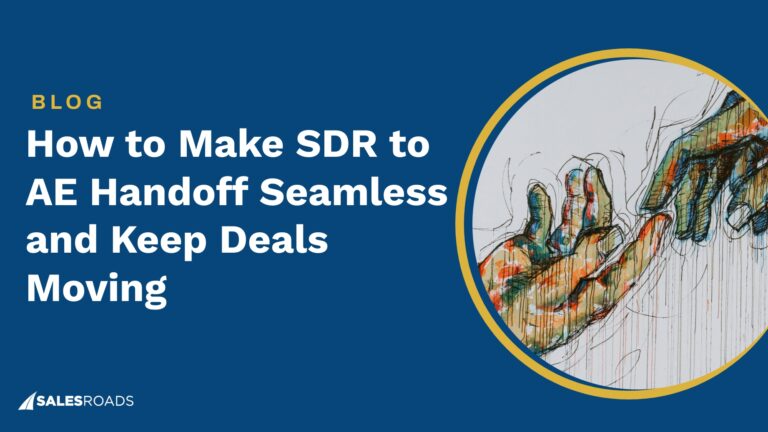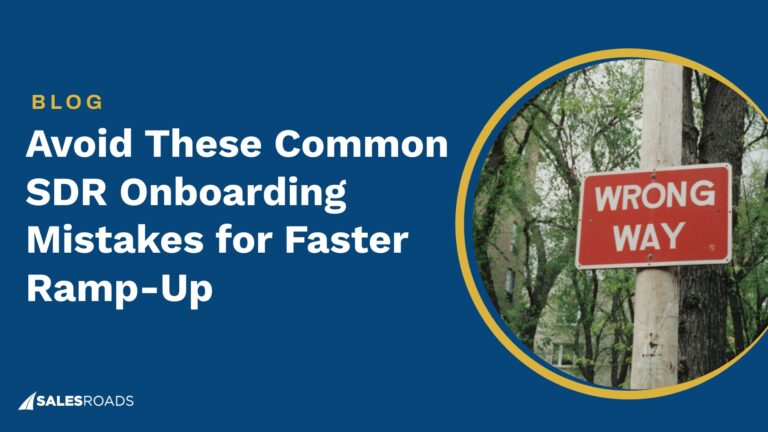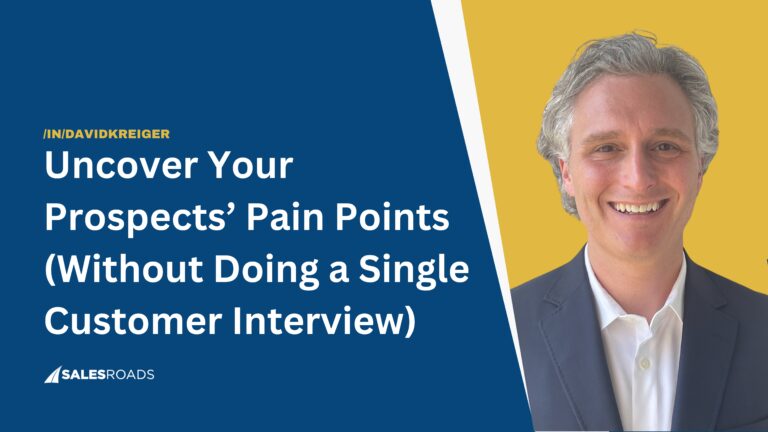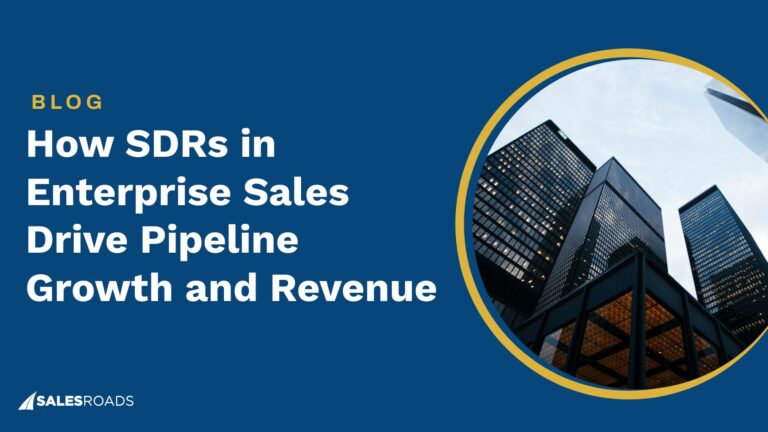Sell Like A Leader – Episode 9
In this episode, we dive into:
– Developing strategy: The real purpose behind a framework and a strategy, strategy vs. tactics, using answer-first thinking, SMART goals and initiatives, the importance of chronicling your work, and why you should track your own metrics in addition to the corporate dashboards.
– Framework #1: The Strategy Slide
– Framework #2: Plan On A Page
– Framework #3: The 6-Pager
– Rapid Fire Q&A
About Ralph Barsi
David Kreiger chats with Ralph Barsi, VP of Sales at Kahua, a leading construction management platform. Prior, Ralph held executive roles at Tray.io and then ServiceNow, where he built and led a team of 230 people across the globe during the company’s growth from $1 billion to over $4 billion in revenue. He is also an advisor at Scale Venture Partners.
Podcast Key Takeaways
- Ralph introduced the “strategy slide” concept, a practical tool for framing long-term vision and strategy. This helps in differentiating strategies from tactics, applying principles like the pyramid principle from McKinsey.
- Episode resource: Get Ralph’s Sample Strategy Slides for AEs and SDR leaders: https://bit.ly/strat-slide-temp
- Ralph emphasized the importance of personal discipline, such as tracking metrics and journaling, to maintain focus and drive growth. He reflected on how journaling has benefitted their personal and professional lives.
Connects
Connect with Ralph Barsi: https://www.linkedin.com/in/ralphbarsi/
Connect with David Kreiger: https://www.linkedin.com/in/davidkreiger
Subscribe to the podcast and follow our Podcast LinkedIn page so you don’t miss any episodes!
Transcript
David: Today, we are chatting about strategy and planning. So lots of takeaways, both for new and experienced sales leaders. Welcome. This is the Sell Like a Leader podcast, the podcast for revenue leaders who are on a mission to cultivate a high-performing sales team within their organization.
I'm your host, David Kreiger, President of SalesRoads, the most trusted sales outsourcing and appointment setting organization. I am very excited to bring you another sales leader, Ralph Barsi. I have seen Ralph very active on LinkedIn, learned from him over the years. I had the pleasure of being on a podcast with him just a month or two ago, and just really enjoyed the insights.
And so was thrilled when he accepted the invite to come on Sell Like a Leader podcast.
Just to give you a little background on Ralph, and then we're going to dive into some of the frameworks that he's come up with over his sales career. He is currently the VP of Sales at Kahua, which is a leading [00:01:00] construction management platform.
And prior to Kahua, Ralph held executive roles at Tray.io and ServiceNow. While at ServiceNow, he built and led a team of 230 people across the globe during the company's growth from $1 billion to over $4 billion in revenue.
No small feat there, Ralph. He's also an advisor at Scale Venture Partners and is an active writer, speaker, and encourage you to check him out after this podcast; he's got a lot of great content out there. But let's get into the show today.
Welcome, Ralph. Thanks so much for being on here.
Ralph Barsi: I'm delighted. Thank you, David. It's great to be here.
David: So, as I mentioned in the intro, we're going to talk a bit about strategy and planning for sales leaders. I've seen some of the frameworks that you've had that I think are really helpful for sales leaders. It's complicated being a sales leader, right?
And so having some frameworks that you can leverage on a day-to-day basis from a planning [00:02:00] strategy standpoint, I think are really important.
And so I'd love to get your perspective on some of the frameworks that you think help sales leaders, have helped you through your career. I'd love to get into some of the details on them. We'd love to start with what you call the strategy slide.
And so maybe you can, you know, start big picture for us. What is the strategy slide? How does it help sales leaders? How does it help you?
Ralph Barsi: Yeah, thanks, David. So, uh, I learned about the strategy slide at ServiceNow, and it was just an outstanding approach to framing up the year ahead, or the quarter ahead, or even the month ahead. And what's cool about it is, you can apply it to a business and a team, or you can apply it to yourself. If you've got some personal goals that you're looking to accomplish, for example, the strategy slide is a great way to do it.
And just to, you know, remind people of strategy versus tactics. Remember that strategies are more that long-term vision and that long-term [00:03:00] plan for things that you're aiming and aspiring to achieve and exceed. Whereas the tactics actually inform the strategy.
So if you're, you know, an NFL football coach, you want to win the Super Bowl—that is your strategy. It’s for winning that Super Bowl, but then the tactics are what inform the day-to-day practices and drills that are going to get that team to head north together towards the Super Bowl.
So, using the strategy slide, I believe it's a derivative of the Pyramid Principle, which comes from McKinsey & Company. And there's a great book by a lady named Barbara Minto called The Pyramid Principle, where it introduces answer-first thinking. So obviously beginning with the end in mind—what is the answer? What is the overarching goal that we are trying to reach, and by when?
And then everything that follows is essentially a question that asks, you know, well, what are the goals or the [00:04:00] initiatives that would serve getting to that answer?
And then beneath those questions, as you dive deeper and deeper: well, what are the KPIs? How would—what are the metrics? How would we manage towards this? Lastly, it's: well, what are the needs that we have? Where are the gaps today? What do we need from other stakeholders? What do we need from the business in general?
And the product of that is essentially a flowchart where at the very top, you've got what the answer is, what the goal is, for example, that you're trying to achieve. And then beneath that top box on the flowchart, you've got three to five boxes in row two.
And there are your key initiatives or your SMART goals. And we can go through those if you'd like.
Beneath those in the third row of the flowchart will be your KPIs. And remember, KPIs—you always want to include, you know, a dollar amount, a percentage amount, or a number. Those are what [00:05:00] are going to define a KPI.
And then the final row, or the bottom row, are the needs that you have of the business or of other stakeholders in order to achieve those KPIs, achieve those SMART goals, and ultimately reach what we call the answer.
David: So I think that this is really important because I think that sales leaders often come in and they're thinking about tactics first. A lot of the blocking and tackling—sometimes they might want to think strategically, but sometimes it's hard to know exactly how to think strategically.
Think maybe about defining our ICP and all those things—that is important—but this is even sort of almost bigger than that. Right? And so I think that having a framework for when a sales leader comes in and is trying to figure out what is going to be their strategy is really important, because I actually haven't seen that many. I've read a lot of, um, process books for entrepreneurs and whatnot.
And the part that is always missing is the sales part. They talk about [00:06:00] some of the very basics, but they don't talk about how to create a sales strategy.
Ralph Barsi: Liver over here? I mean, come on, you got to throw sales a bone.
David: Why are we always left out? We're always the stepchild. He's always bringing in the bone, right?
Ralph Barsi: Yeah, they'll figure—anyway. Anyway, so we digress. You are 100 percent right. And one thing that has always helped me when I'm even thinking about what framework should we apply in this situation is, it reminds me of a great quote from Confucius, which was, or is, “You have to set things in order before there is confusion.”
So if we don't have a center to return to when things get a little wild in the middle of a quarter or a year, it's just going to continue to be wild. And so in order to set things in order and come back to center and find out, well, what is it that we set out to do initially? Therein lies the real purpose behind a framework and a strategy.
David: First of all, you get a gold star. I think that is the first time Confucius has been brought up on my [00:07:00] podcast, and I love it.
With that, though, to try to create—and I'd like to actually dive into that quote a little bit and talk about how the confusion ensues afterwards. But let's talk about the order first.
So let's break down this strategy slide a little bit. So, can we start with maybe just some, you know, general example, you know, of what an answer would look like? How do we start with the end in mind? You know, if there's an example, or how do we think about—we're going to talk about that and figure out what is the answer that we're trying to begin with as we develop our strategy slide?
Ralph Barsi: Sure. What we'll do is, uh, we'll use the scenario of an individual contributor. So, talking about sales, here would be maybe a step-by-step guide for how an individual contributor who owns a territory, who owns a quota, and is embarking on their fiscal year or fiscal quarter, how they would frame something up.
And I don't want to overengineer this, and I don't want the listeners to overengineer it either. This is as simple, actually, as [00:08:00] pulling out a blank piece of paper and, you know, creating a little flowchart with four to five rows, okay?
And at the very top, there's a box that could say: Deliver results and earn my on-target earnings, drive closed-won deals, and a repeatable, viable pipeline, quarter over quarter. Okay. So that's what we're trying to achieve. We want to be high performers.
We might want to go to President’s Club next year. That's a pretty simple, straightforward charter.
Now, row two—just beneath that answer—you have your three to five initiatives or what we call SMART goals, because obviously they're measurable, they're timely, and we're trying to get from X to Y by when in a certain amount of time. So here are examples of what three to five SMART goals or initiatives could sound like for that individual contributor.
Number one, we want to maintain an active pipeline of 3X our quota quarter [00:09:00] over quarter. We want to meet 75 percent-plus quota attainment, which is a minimum of three of four quarters.
So that's a great measurable goal to go after. Number two would be, let's sell the cars on the lot. A lot of individual contributors, even if they're new to an organization, will often inherit a pipeline and a territory. Others. Generate the pipeline on their own, which is fine.
But then you've got this pipeline of opportunities that are just sitting there.
And so it's critical that you sell the cars on the lot. It's one thing to be excited about generating more and more pipeline, but let's not leave the opportunities behind that are already in our pipeline. So convert, nurture, or dump all the dormant opportunities in our pipeline.
For example, any opportunities that are over 60 days old, and let's do that each quarter.
Third initiative would be, we want to keep stakeholders apprised. So let's [00:10:00] implement maybe weekly or monthly updates. Internally, and externally, let's send recap emails to 100 percent of the stakeholders in our pipeline that we have. Uh, fourth example would be you want to sharpen the saw.
So now I'm quoting Dr. Stephen Covey. You want to say enroll in one class per quarter. You want to listen to every episode of Sell Like a Leader this quarter. You know, maybe you want to read and summarize one book per month.
And you want to do that publicly. Maybe you want to do that on Facebook, Twitter, or on LinkedIn and share what you're learning with all of us who are all in your marketplace.
We're trying to learn too. So what better way to impart what you're learning than publicly? And then lastly, the last initiative would be schedule meetings in the field twice per quarter and meet in person with your top customers and prospects. So we've covered Row 1, which is the [00:11:00] answer, and now we've covered Row 2, which is, you know, the key initiatives or the SMART goals.
I'll pause there in case you've got questions; otherwise, I'll just keep rolling.
David: Yeah, no, this makes sense. So I think recap again the answer at the top, and then maybe each of these, and then we can go into the KPIs.
Ralph Barsi: We're an account executive. We're an individual contributor and seller in the field. So our answer for the quarter or for the year, you pick the time frame that you'd like to apply this strategy to, is to deliver results.
And to earn your on-target earnings, meet and/or exceed quota, make it to President's Club, whatever that looks like, and drive closed-won deals and a repeatable, viable pipeline quarter over quarter.
So that obviously, you can continue this track record and build upon it over the quarters or years.
David: You usually recommend having five different initiatives, like multiple initiatives that will help you get to that answer?
Ralph Barsi: You know, great question, David. It depends. Some people are [00:12:00] cool with two initiatives. It works for them. It keeps things simple. It helps them to focus. Others prefer five or more. I would not recommend more than five, because I think it's aesthetically easy to look at if you're looking at it on paper. And it's very easy to remember if you just look at your hand and go, Initiative 1, and 5.
And it just keeps things very clear and front of mind. And one other tactic, uh, if you will, is to put a reminder on your calendar, maybe on the 1st of the month or maybe the 15th of the month or midway through the quarter as to what this answer is that we're trying to achieve. So that it is always at the forefront of your day-to-day operation.
David: And so basically the answer is like your North Star. It's like what you're running towards, the Uber goal. So can we go and maybe break down a few of them, maybe just stating the initiative and then what the KPI would be from there.
Ralph Barsi: Absolutely. So that first initiative we talked about was maintaining an active [00:13:00] pipeline of 3x to say 5x of your quota and maintaining it quarter over quarter. So that you've got a stack of firewood, if you will, to pull from. If the fire starts to go down, you want to, you know, stoke that fire and make sure that the flame is burning hot.
And that comes from viable pipeline that's being built upon quarter over quarter. So three metrics on how we would drive that initiative include, well, we need to keep track of the number of net new opportunities that we have in our pipeline. We want to look at the percentage of opportunities that have moved past a specific stage in the pipeline.
We want to make sure that, like I said, we're selling the cars on the lot or at least moving them forward towards maturity, moving them up or out of the pipeline. A third metric would be obviously how much ARR, for example, have we closed-won this month, or this quarter, or this year. So those are three key metrics that would inform that very first initiative.
David: You recommend people keep their own [00:14:00] dashboard to look at on a week-to-week basis, or they just kind of look at the Uber dashboard and kind of, you know, look at what these KPIs are for their own strategy?
Ralph Barsi: So, in my experience, unfortunately, most people default and defer to the general dashboards that the company looks at or their sales leader looks at. That's good and fine. I am not discouraging that, but I am heavily encouraging you to always keep track of your own metrics elsewhere. So I also include journaling and chronicling of your work in this same vein.
You have to know in your heart, the activity and the progress, or lack thereof that you're making on a day-to-day basis, because at the end of the day, David, as you know, no one cares about your growth path and your trajectory more than yourself.
And so you're going to run into rough patches. Not every day is [00:15:00] glorious.
Not every quarter is outstanding. Not every fiscal year is successful. So you're going to need to chronicle your work so that you can actually look back and remind yourself, you know what? I can do this. I am capable of doing this.
I've been, you know, managing what I've measured, perhaps I need to adjust what I'm measuring, perhaps there's a kink in my systems or my processes that I need to diagnose a little further and make readjustments and refinements, but I can do this and I can achieve this answer in this overall goal that I'm going after.
And in the quiet of night, that's when you can, you know, really remind yourself that you can do this, and you're not going to get it from everybody at work, and you're certainly not going to get it from the corporate dashboards.
David: So something I've been doing since COVID, since 2020, is keep a line-a-day journal, um, where basically I write a little something every night and then I can look [00:16:00] back over the past four years on what I was writing. And so it serves two purposes.
One, obviously, I think it's great to do some journaling.
Sometimes we don't have time. It feels overwhelming. This is just, you just write a little something about what's happening. Personally, professionally, whatever you're feeling at that moment. But then the real magic happens when you reflect and you get to see what was happening in your life a year ago, two years ago, three years ago.
And I'm at that tail end. I'm kind of sad because next year I've got to open up a new one and sort of start fresh, but I get to see what's happened over the past five years. And obviously it's been a rollercoaster, right? With COVID and then, you know, the boom of ‘21 and all these types of things.
And perspective is so important in a sales career, in an entrepreneurial career, in life in general, and seeing—we forget sometimes how low we felt or how good we felt—and then realizing that it's never as good or as bad as it seemed, right?
And so the perspective I've gotten by looking back on that when I go through ups and downs, has just been [00:17:00] really helpful for me. And I think that's what you're speaking to. So a little anecdotal way to sort of keep some of these, you know, thoughts over the course of a few years.
Ralph Barsi: I'm really happy to hear that you're doing that, David, and I hope more people are doing that. It reminds me of the analogy of when the oxygen mask drops on an airplane and you have to put it on you first before you can help others.
And the same applies to this journaling and this retrospective exercise that you do and this reflection that you're doing because, you know, in order to sell like a leader and serve like a leader, everything that you're learning along this path and through these experiences, you have to learn as if you need to teach others what it is you've learned so that they can be better in their own world and they can get down their path that they're trying to achieve.
So I always write as if A, I'm reflecting, you know, for myself, but also for the up-and-comers. There are people two years, five years, ten years from now who [00:18:00] will run into similar experiences, ask how I overcame them. And with clarity of thought, I'll be able to articulate how I overcame big obstacles so that, in turn, it can hopefully help them do it.
David: Yeah, and one last anecdote on that. I know I want to get to the needs from the business here and how KPIs translate into that.
But I have also found that, like you said, when we teach things to other people, that's when we learn it best. And so that's one of the pleasures of being a leader is that as we mentor people, as we talk to people, we learn things and we get more out of that relationship sometimes than they do, because we're relearning things, we're re-remembering things, and we learn better through reflection.
A lot of anecdotes here, but Ralph, bring us on home here with, you know, the needs for the business and how that finalizes the strategy slide.
Ralph Barsi: I will, David. And here's the good news is, uh, you know, I'm gonna happily share this with you and your listeners. So if we don't get through everything in the time that we have, I'll at least have a leave behind [00:19:00] for everybody to learn from.
David: That'd be great.
Ralph Barsi: But we talked about, again, we started with the answer. Then we followed that with our key initiatives or SMART goals.
And then we followed that with the metrics that we're going to use to measure our progress against the. So, how we finish it out is we have asks of other people, whether it be people on our team, our direct leaders, or the business in general. So I'll just take the example of we wanted to maintain that active pipeline of 3 to 5x quota.
You know, we're tracking number of net new ops, percentage of ops passed a specific stage in the pipeline, dollars of opportunities that have been closed-won. And now in this final bottom row of our flow chart, we might need 2500 per month or something from the business to use it for pipe gen.
Maybe we need to leverage an outsourced inside sales team to help us build that pipeline.
Uh, maybe we need to bring a sales [00:20:00] development rep in-house. So we are asking the business for this kind of help, and this is the budget that we think needs to be allocated to make that happen. So that's an example of how you would take your answer and run it down a key initiative to the metrics to the asks of the business to achieve your goal.
David: If you could send over, we'll put it in the show notes. So people can see what this looks like and really visualize it. One last thing, just so people have a sense of when to use it, and then I want to touch on the other frameworks here, but we won't go as deep. Are there certain times when you like to bring it out?
Is it quarterly planning when you start up? Like, when should people use the strategy slide?
Ralph Barsi: Yeah, typically at the beginning of a catalyst event or the beginning of a period of time. So, you know, an appropriate time would be maybe three months before a fiscal year begins. You crack this thing open and you start, you know, building a straw man of what you want the next year to look like.
It could be at the beginning of a [00:21:00] quarter, uh, it could be at the beginning of a month. It applies to a company, it applies to a team, and it could apply to yourself as well. So, you might want to accomplish something even this week, or you might have a 30-day, uh, plan to knock something out. Maybe you want to write an article, maybe you want to start a business.
It's a great framework to use, uh, in all of those instances. It's super effective.
David: That's awesome. Well, let's touch on the second framework you have, which is plan on a page. Can you just talk to us a little bit, just high-level, as to what that is and how people can use it?
Ralph Barsi: Yeah. So, a lot of listeners are probably familiar with OKRs or Objectives and Key Results. Comes from a great investor and leader named John Doerr. And what has spun off of OKRs, which is relatively the same thing, is what we call a plan on a page.
And it serves the purpose of literally being able to show anybody a single page, and they will be [00:22:00] able to grasp immediately what it is you're trying to accomplish, and how well you're reconciling against that goal.
So this is just a typical table with probably four columns. On the far left, you would list your priority. Maybe, um, you've got a sales development priority, and then beneath that you have a sales priority, and then beneath that you have a customer success priority.
So those are your priorities if you were overseeing a number of different business functions in a business.
On the column to the right, that's again where we put our key initiative or our SMART goal. On the column, the third column over to the right, this is where we establish who owns this. So, if there is a sales development leader, or sales leader, or customer success leader, I would presume they would be the owner of these initiatives.
And then the fourth column is just the status—how well we're doing against the key initiative or SMART goal. And that's indicated by kind of, you know, green, amber, [00:23:00] red. So you could just at a glance, look at how well you're doing against those goals. That's what a plan on a page looks like.
When you do it at scale, you've actually requested this plan on a page from all leaders in the business function. And it rolls up to a grander plan on a page for, say, an entire sales team or an entire marketing team. And that's how the plan on a page works.
David: So the last framework that you leverage is the six-pager. Can you walk us through that as well, Ralph?
Ralph Barsi: Yeah, the six-pager is from Amazon. Uh, it's from Jeff Bezos where, uh, many, many years ago he decided to ban PowerPoints and slide decks altogether from Amazon meetings because he didn't feel that there was a narrative in a lot of the slide decks, and frankly, that the presenters themselves were able to hide behind a very simply built slide and they could move on without a lot of context not being given and a lot of problems not being faced. [00:24:00]
So he issued a directive that everybody, especially on the leadership level throughout Amazon, had to sit down and write out a six-page memo or a six-pager that was broken into a couple of different sections, and then they would deliver that six-page memo at the beginning of every meeting.
And literally people would sit around the table reading the six pages for an awkward 20 to 30 minutes in silence, making notes in the margins, and then there would be robust dialogue following that.
And now this presenter in the past, who was, you know, hiding behind these, uh, slide decks was very exposed. But here's the upside.
When you lean into writing a six pager, suddenly, there is clarity of thought, you're able to articulate an initiative, you're able to articulate the tactics behind an initiative, and you've already thought through what the risks are, [00:25:00] and thought through as well what the contingency plan or plans are to mitigate that risk.
So, in short, to break down a six-pager, you have an introduction, and you have goals just to lay it out, basically the synopsis of what it is we're trying to accomplish. Secondly, you've got tenets or principles that kind of underscore or underpin those goals in that introduction.
So maybe there's a company value, like we're all about continuous improvement, or we're about work-life balance. Those are examples of principles that you could use to inform: this is why this is a goal we are aiming to achieve this quarter of this year.
Number three would be, you know, your articulation of the state of your business, where you really write out: this is how the year has gone so far. These are the challenges we've faced. This is how we've overcome them. These are challenges we anticipate coming down the pike as the year goes on, based on [00:26:00] macro or microeconomic trends.
Essentially, the state of the business is the third section. And there's two more.
The fourth section is: these are the lessons that we've learned. And number five is: here are the strategic priorities that we have moving forward. So obviously, the six pager is much more thorough than the other two frameworks we've discussed. That resonates with a lot of people that might be listening, thinking, you know what, I probably do need to lean into this a little more.
So, one way you can do that is perhaps you create a strategy slide or a plan on a page. Personally, you've kind of written a six-pager to yourself so that when you're grilled on it, or when people want to get into robust conversation and dialogue, you're kind of ready for it because you've already written it out and you're very clear about how you want to proceed.
David: And so I think this framework is interesting. I think the Uber concept of what Jeff Bezos is trying to achieve through this is, I think, brilliant. And we've tried at [00:27:00] SalesRoads to implement it in a little bit of a different way. But I think we know that a lot of meetings just are a waste of time.
Part of it is because people come with a PowerPoint presentation. They create this flow of this story. People can kind of ask questions as you go through, but it's not the most effective way to really dig deep, get under the covers with some of the real issues, and really have a productive dialogue around what you're trying to solve.
Because when you see something for the first time, or I know Jeff Bezos gives 20 minutes at the beginning, and so people have time to really think about it and not react with questions. I actually like what we do. If there's anything that's going to be presented that's meaty, people have to send it out 24 hours in advance so that people have time to review it.
Because it's sometimes really hard to process, especially when you're talking about complicated questions, things on the spot, and think of the right questions.
And sometimes it's hard to know what questions you're asking if you're just seeing the beginning [00:28:00] of the presentation—remember what was versus the end.
Whereas if you can read something, uh, you know, holistically, think about it deeply, and then come prepared to be able to ask the right questions, have some thoughts around it, it isn't just a knee-jerk reaction or the person who can just think really quickly. It's the people who've really taken time to ponder it, think through it.
And that's where you get some really innovative answers to some really hard problems, I think.
Ralph Barsi: You know what else, David? I have found in writing out a business plan or a goal for the quarter it kind of removes emotion from everything. You can bring a more objective perspective into it.
David: Yeah, so, well, that's great. Well, thank you very much, Ralph, for sharing these frameworks. The framework for strategy, I think, needs to really be developed. It's helpful to see some things that have worked for you and for your team that you've picked up as you've gone along.
We're nearing the end of the episode, I'd love to just ask you a few questions, and you can give the audience just a [00:29:00] sense of your perspective on that.
So does that sound okay? Yeah.
Ralph Barsi: Sure. Let's rock.
David: What is one thing people don't give enough value or attention to in leadership?
Ralph Barsi: That you're there to serve. You're there to serve others.
David: Skill you advise everyone in sales to master, leaders or non-leaders?
Ralph Barsi: Without question, communication. It's the most underrated skill in business, in my opinion. I don't think enough attention is given to it. And by that, I mean knowing how to write well, knowing how to speak well, knowing how to listen well so that you can engage with other human beings.
Communication, without question.
David: Favorite business, leadership, or sales book?
Ralph Barsi: My favorite is Wooden on Leadership, and that's John Wooden, who was the late UCLA basketball coach. If there were others to recommend, I would go for James Clear's Atomic Habits or Brian Tracy's Eat That [00:30:00] Frog.
David: Yeah, all good ones. Favorite quote, mantra, or saying that inspires you as a sales leader?
Ralph Barsi: Favorite quote comes from cartoonist and writer Scott Adams. It is: Losers have goals. Winners have systems.
David: Not breaking out Confucius on this one, huh?
Ralph Barsi: No, although that's a close second.
David: What's the most important goal or project you're working on right now?
Ralph Barsi: Oh, right now, is getting Kahua to over $100 million in revenue.
David: Fantastic. Well, Ralph, thank you again for coming on the podcast, sharing your experience, knowledge, frameworks. Where can people connect with you online or learn more about the work you do?
Ralph Barsi: Thanks, David.
Best way to find me is my blog, which is ralphbarsi.com. On LinkedIn it's linkedin.com/in/ralphbarsi, and on Twitter it's @rbarsi — and it's R-A-L-P-H-B-A-R-S-I. Really excited to be here. [00:31:00] Thanks for having me, David.
David: Thank you very much, Ralph, for taking the time. I know you're busy traveling around, and so we appreciate it. This was a great episode, great frameworks.
And listeners, I hope you got a lot of value out of this. Check out the show notes so you can see some of the frameworks visually. And if you like what you heard here, please subscribe to Sell Like a Leader podcast on your platform of choice.
And always feel free to reach out to me on LinkedIn at David Kreiger. Love to hear your feedback, things you'd like to see on the podcast.
Thanks so much. Hope everyone has a great day.









